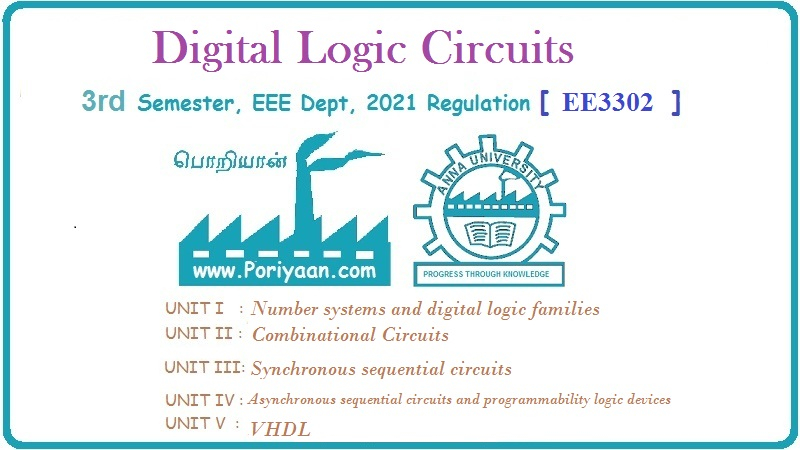Digital Logic Circuits: Unit II: Combinational Circuits
Five-Variable K-map
with Example Problems
A 5-variable K-map requires 25 = 32 cells, but adjacent cells are difficult to identify on a single 32-cell map. Therefore, two 16-cell K-maps are generally used.
Five-Variable K-map
A
5-variable K-map requires 25 = 32 cells, but adjacent cells are difficult to
identify on a single 32-cell map. Therefore, two 16-cell K-maps are generally
used. If the variables are A, B, C, D and E two identical 16-cell maps containing
B, C, D and E can be constructed. One map is then used for A and the other for ![]() See Fig. 3.6.1.
See Fig. 3.6.1.
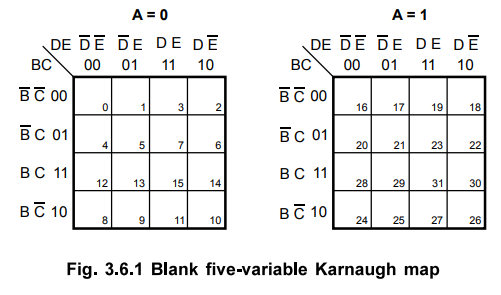
It is important to note that in order to identify the adjacent grouping in the five variable map, we must imagine the two maps superimposed on one another; not "hinged" or "mirror imaged". Every cell in one map is adjacent to the corresponding cell in the other map, because only one variable (i.e. A) changes between such corresponding cells. Thus, every row on one map is adjacent to the corresponding row (the one occupying the same position) on the other map, as are corresponding columns. Also, the rightmost and leftmost columns within each 16-cell map are adjacent, just as they are in any 16-cell map, as are the top and bottom rows. However, the rightmost column of one map is not adjacent to the leftmost column of the other map, since those are not corresponding columns. Nor is the top row of one map adjacent to the bottom row of the other. This is illustrated in Fig. 3.6.2.
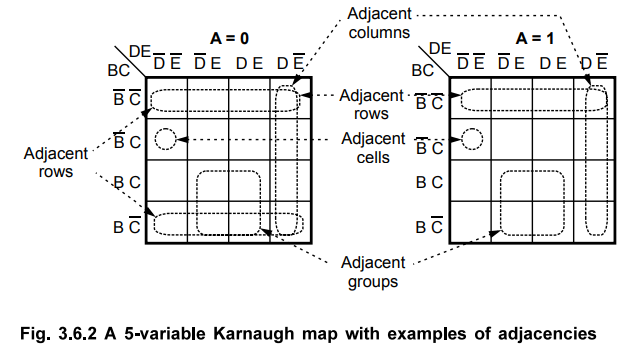
Examples
for Understanding
Ex.
3.6.1 Simplify the Boolean function.
f
(A, B, C,D,E) = ∑ m (0, 2, 4, 6, 9, 11, 13, 15, 17, 21, 25, 27, 29, 31)
Sol.
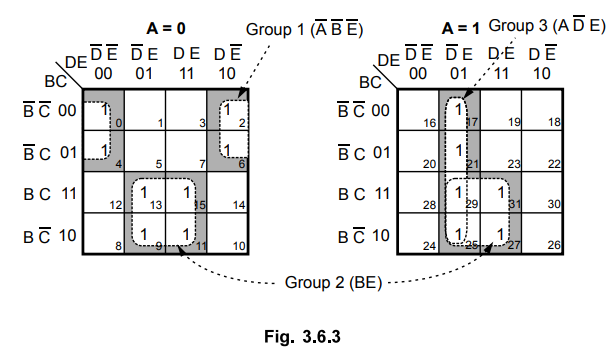
The
first 16-cell map has 2 quads. The second quad is adjacent to quad in the
second 16-cell map. These two quads are grouped and referred to as group 2. The
second 16-cell map has another quad which is referred to as group 3. Therefore,
the simplified expression is

Ex.
3.6.2 Simplify the Boolean function.
F(A,
B, C,D,E) = ∑m (0, 5, 6, 8, 9, 10, 11, 16, 20, 24, 25, 26, 27, 29, 31)
Sol.
:
As shown in the Fig. 3.6.4 there are two isolated Is. These Is are referred as
group 2 and group 3, respectively. Group 1 is formed by combining two adjacent
pair of Is from two different 16-cell maps. The combination of two quads from
two different 16-cell maps gives the group 4. The second 16-cell map has one
pair and another quad which form group 5 and group 6 respectively. Therefore
the simplified expression is
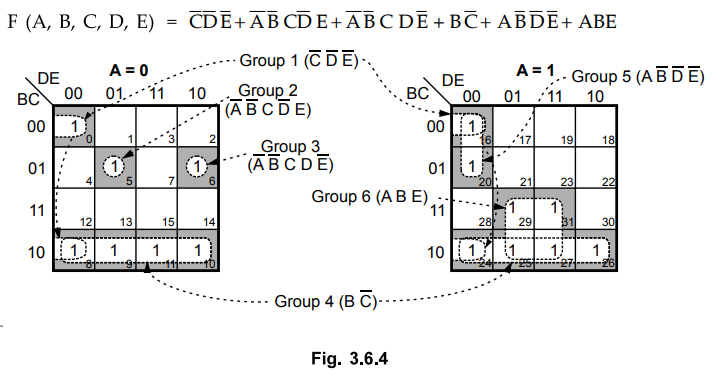
Ex.
3.6.3 Reduce the function using K-map technique
F(A,
B, C,D,E) = ∑ m (1, 4, 8,10,11, 20,22,24, 25, 26) + d (0, 12, 16, 17)
Sol.
:
The given function is plotted on the K-map with don't care conditions as shown
in the Fig. 3.6.5. Here don't care conditions are taken as Is to form pairs and
quads. The group 1 is formed by combination of two pairs from two different
16-cell maps. Group 2 is quad within the first 16-cell map group 3 is formed by
another combination of two pairs from two different 16-cell maps. The first
16-cell has one more pair of Is which is referred to as group 4. Group 5 and
group 6 are the quad and pair from the second 16-cell map, respectively.
Therefore,
we get simplified expression as
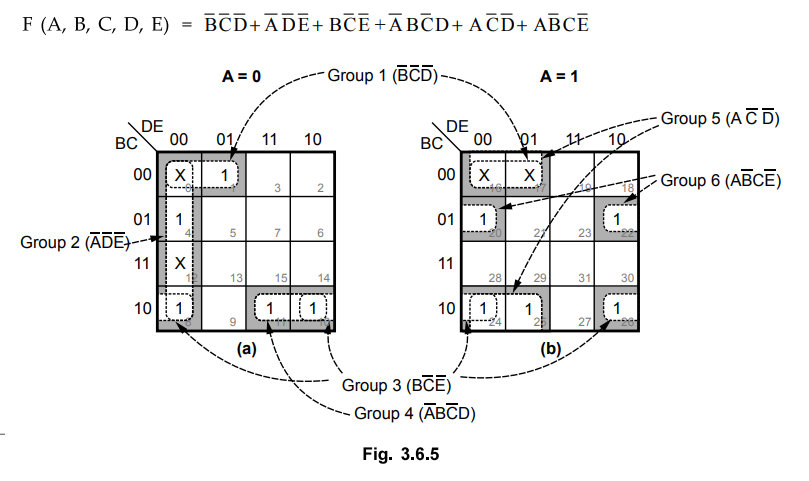
Examples
with Solutions
Ex.
3.6.4 Simplify the following switching function
f(x1
,x2 , x3 , x4 , x5) = ∑ m (1, 3,
6,10,11, 12, 14,15,17, 19, 20, 22, 24, 29, 30)
AU
: May-08, Marks 8
Sol.
:
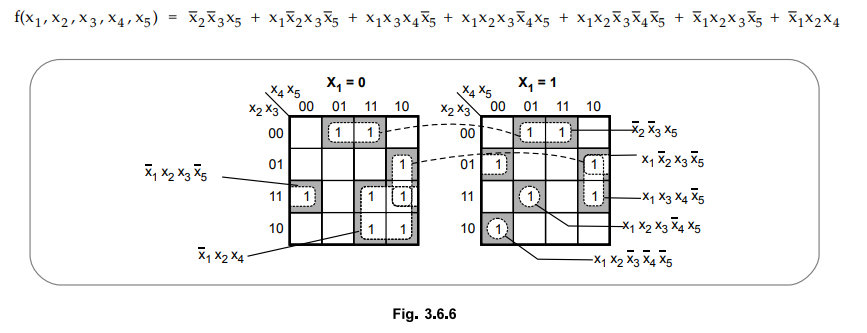
Ex.
3.6.5 Simplify the five variable switching function
f(EDCBA)
= ∑ m(3, 5, 6, 8, 9, 12, 13, 14, 19, 22, 24, 25, 30).
Sol.
:
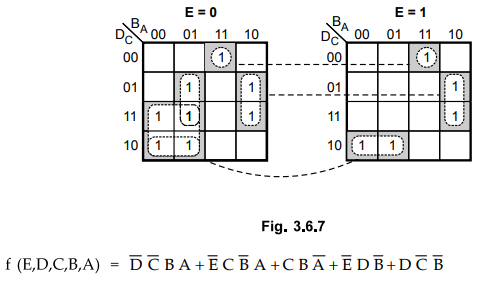
Examples
for Practice
Ex.
3.6.6 Use the K-map method to simplify the following 5 variable function
F
= ∑ (3, 6, 7, 8,10,12,14,17, 19, 20, 21, 24, 25, 27, 31)

Ex.
3.6.7 Apply branching method to simplify the following function.
F(A,B,C,D,E)
= πM(0,1, 4, 5, 9,11,13,15,16,17, 25, 27, 28, 29, 31)
d(20,
21, 22, 30)

Digital Logic Circuits: Unit II: Combinational Circuits : Tag: : with Example Problems - Five-Variable K-map
Related Topics
Related Subjects
Digital Logic Circuits
EE3302 3rd Semester EEE Dept | 2021 Regulation | 3rd Semester EEE Dept 2021 Regulation
